 |

 |
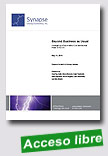 |
Beyond Business as Usual: Investigating a Future without Coal and Nuclear Power in the U.S.
Synapse Energy Economics for the Civil Society Institute, May 11, 2010, 91 p.
The electric power industry in the U.S. is at a crossroads. The nation is struggling to develop an effective mechanism to combat climate change. At the same time we are poised to spend hundreds of billions on new pollution controls at coal-fired power plants, and these controls will do nothing to reduce CO2 emissions. Carbon capture and sequestration at coal plants is still in the demonstration stage and cost estimates are
|
escalating. The nation is also running headlong toward a new generation of nuclear plants. However, cost estimates for these plants are skyrocketing – again – and we still have not established a central repository for radioactive waste. This waste remains stored at nuclear plants across the country. The risk, cost and complexity of a future based on coal and nuclear power look increasingly daunting.
This study investigates a long-term, national strategy to transition away from coal and nuclear electricity and toward increased efficiency and renewable energy. The focus of the study is on what resources would be likely to replace coal-fired and nuclear generation, where they are located, and what this resource mix would cost relative to a “business as usual” energy future.
The study finds that a future built on more efficient use of electricity and development of the nation’s renewable resources would pose modest near-term costs but would cost less than business as usual over the long term
Extraído de:
http://www.synapse-energy.com/Downloads/SynapseReport.2010-05.CSI.Beyond-Business-as-Usual.10-002-Executive%20Summary.pdf
Resumen ejecutivo | Texto completo
|
 |
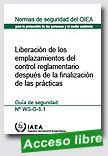 |
Liberación de los Emplazamientos del Control Reglamentario después de la Finalización de las Prácticas
OIEA Colección de normas de seguridad, 2010, 53 p.
La presente guía de seguridad tiene por objeto proporcionar orientación al órgano regulador y a los explotadores sobre la liberación de emplazamientos o partes de emplazamientos del control reglamentario después de la finalización de las prácticas. Esa liberación del control reglamentario puede requerir la limpieza de los emplazamientos contaminados y esta publicación también proporciona orientación a ese respecto
|
Extraído de:
http://www-pub.iaea.org/MTCD/publications/PDF/Pub1244s_web.pdf
|
 |
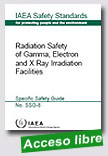 |
Radiation Safety of Gamma, Electron and X Ray Irradiation FacilitiesSafety Guide
IAEA Safety Standards Series, 2010, 94 p.
This Safety Guide provides recommendations on how to meet the requirements of the Basic Safety Standards with regard to irradiation facilities. It gives practical information on the safe design and operation of gamma, electron and X ray irradiators in accordance with these requirements, discusses the beneficial applications of ionizing irradiation and how to avoid potential radiation hazards at industrial irradiators, including contamination arising from damaged radioactive sources. The Safety Guide is intended for use by the designers and operating organizations of these facilities and also by regulatory bodies.
Contents: 1. Introduction; 2. Justification of practices; 3. Types of irradiator; 4. Principal elements of practices; 5. Individual monitoring of workers; 6. Workplace monitoring; 7. Control over radioactive sources; 8. Irradiator design.
|
Extraído de:
http://www-pub.iaea.org/MTCD/publications/PubDetails.asp?pubId=8401
|
 |
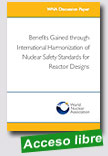 |
Increasing worldwide recognition of nuclear power as a major future energy source - providing benefits for national energy independence as well as global environmental preservation - is reflected in recent declarations by the G8 and the OECD’s International Energy Agency, in the policies of many governments, and in creation of the Global Nuclear Energy Partnership.
For potential investors, however, global expansion of nuclear
|
power continues to be viewed primarily through a financial and economic prism that focuses particularly on nuclear power’s competitiveness visà-vis other sources of base-load power such as coal and gas.
A major factor in this equation is the potential for economies of scale achieved by building plants in series.
Currently, national variations in safety regulations present an obstacle to internationally standardized nuclear reactor designs, which would foster these economies. The achievement of harmonization of nuclear safety standards could overcome this obstacle, facilitating the emergence of a global market that offers a choice of a small number of reactor types that are recognized by regulators as safe and technologically mature. This important step could kick-start serial reactor construction worldwide
Extraído de:
http://www.world-nuclear.org/uploadedFiles/org/reference/pdf/ps-cordel.pdf
|
 |
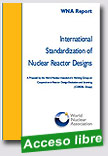 |
International Standardization of Nuclear Reactor Designs
World Nuclear Association, s. d., 36 p.
International standardization of goods and services is a familiar concept. To be feasible, standardization requires that a technology be sufficiently mature to employ designs of well-established quality and safety. This is precisely the case for today's nuclear reactor designs, which represent the culmination of more than 50 years of development.
The concept of standardized reactor designs looks towards a future in which reactors can be built in any country without the necessity of adaptation to specific national regulations. Certainly
|
such standardization will be crucial if nuclear power is to realize its full potential as a major contributor to the clean-energy needs of tomorrow's world. Standardized designs will also contribute to safety in nuclear construction and operations, especially as reactors are deployed in countries that are just beginning to introduce nuclear power. Achieving reactor design standardization will require the combined efforts of industry, regulators, policymakers, governments and international institutions.
In this paper, the WNA's CORDEL Group proposes a conceptual three-phase programme introducing a mutual acceptance and eventually internationally valid design approvals for standardized reactor designs. But such an evolution towards internationally valid design approvals would necessarily occur in a manner consistent with each country's sovereignty over its own regulatory framework. Each country's regulator would remain responsible for a comprehensive licensing and oversight process, with a streamlined design approval simply being one part of it. No aspect of the CORDEL proposal is meant to imply that any
national regulatory process would be subordinated or limited by foreign decisions.
Extraído de:
http://www.world-nuclear.org/uploadedFiles/org/reference/pdf/CORDELreport2010.pdf
|
 |
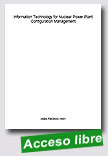 |
Information Technology for Nuclear Power Plant Configuration Management
IAEA TECDOC Series, 2010, 117 p.
Configuration management (CM) is an essential component of nuclear power plant design, construction and operation. The application of information technology (IT) offers a method to automate and ensure the timely and effective capture, processing and distribution of key nuclear power plant information to support CM principles and practical processes and procedures for implementation of CM at nuclear power plants.
|
This publication reviews some of the principles established in IAEA-TECDOC-1335,
‘Configuration Management in Nuclear Power Plants.’ It also recaps tenets laid out in IAEATECDOC-1284, ‘Information Technology Impact on Nuclear Power Plant Documentation’ that supports CM programmes. This publication has been developed in conjunction with and designed to support these other two publications. These three publications combined provide a comprehensive discussion on configuration management, information technology and the relationship between them. An extensive discussion is also provided in this publication on the role of the design basis of the facility and its control through the CM process throughout the facility’s lifetime.
While this report was developed specifically for nuclear power plants, the principles discussed can be usefully applied to any high hazard nuclear facility.
Extraído de:
http://www-pub.iaea.org/MTCD/publications/PDF/te_1651_web.pdf
|
 |
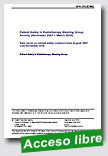
|
Patient Safety in Radiotherapy Steering Group Activity (November 2007 - March 2010)
Health Protection Agency (HPA), July 2010, 34 p.
This report provides a summary of both the collaborative project by the Patient Safety in Radiotherapy Steering Group with the radiotherapy community to improve patient safety in RT and an analysis of patient safety incident reports from August 2007 to November 2009 completed by the Health Protection Agency (HPA)
Since the publication of Towards Safer Radiotherapy [1] (TSRT)
|
the HPA, in .conjunction with the National Patient Safety Agency (NPSA), has continued to work closely with partner organisations to develop a new voluntary reporting system which can be used to analyse patient safety incidents in relation to radiotherapy errors.
This system makes use of the National Reporting and Learning System (NRLS) at the NPSA, allowing radiotherapy error reports to be completed using the same process as other patient safety incident reports but employing a trigger code TSRT9 and a dedicated coding system, which describes where in the radiotherapy pathway the error occurred and for the classification, which defines the severity of the error of RTEs as described in TSRT[1]. This enables the radiotherapy specific data, to be easily extracted from the NRLS. The Patient Safety in Radiotherapy Steering Group was set up to monitor the implementation of the recommendations from TSRT[1], in the first two years since publication. The Steering Group was chaired by the NPSA until 31st March 2010, with the HPA, taking over this function as of the 1st April 2010
Extraído de:
http://www.hpa.org.uk/Publications/Radiation/
CRCEScientificAndTechnicalReportSeries/HPACRCE002/
|
 |
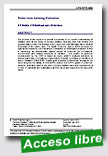 |
Risks from Ionising Radiation
Health Protection Agency (HPA), April 2010, 26 p.
The HPA is required to advise government and other stakeholders on the application of ICRP recommendations in the UK. Such advice is based on an objective review of the scientific evidence and its application in the development of standards, informed by direct involvement in epidemiological and biological research as well as substantial experience in setting protection criteria.
This report provides a brief commentary on the basis for current
|
radiation risk estimates, referring to the comprehensive reviews undertaken by the United Nations Scientific Committee on the Effects of Atomic Radiation (UNSCEAR) and to the assessments that form the basis for recommendations issued by the International Commission on Radiological Protection (ICRP).
HPA endorses the approaches adopted by the International Commission on Radiological Protection (ICRP) in developing an internationally agreed system for protection in various situations of exposure. Hence, HPA is presenting the views of the vast majority of people working on radiological protection throughout the world.
Extraído de:
http://www.hpa.org.uk/Publications/Radiation/HPARPDSeriesReports/HPARPD066/
|
 |
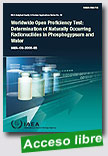 |
World Wide Open Proficiency Test: Determination of Naturally Occurring Radionuclides in Phoshogypsum and Water
IAEA Analytical Quality in Nuclear Applications Series, 2010, 182 p.
A reliable determination of naturally occurring radionuclides in phosphogypsum is necessary to comply with the radiation protection and environmental regulations.
This proficiency test (PT) is one of the series of the world wide proficiency tests organised every year by the IAEA Terrestrial Environment Laboratory. This series of PTs is designed to
|
identify analytical problems, to support Member State laboratories to maintain their accreditation and to provide a forum for discussions regarding the analysis of naturally occurring radionuclides. The range of sample types available for analysis has been mainly at environmental levels.
In this PT, the test item set consisted of six samples: one phosphogypsum (the IAEA-434 reference material) and five water samples spiked with natural radionuclides. The main task of the participating laboratories was to identify and traceably quantify the activity levels of radionuclides present in these matrices. The tasks of the IAEA were to prepare and distribute the samples to the participating laboratories, to collect and interpret analysis results and to compile a comprehensive report.
Extraído de:
http://www-pub.iaea.org/MTCD/publications/PDF/IAEA-AQ-18_web.pdf
|
 |
|
|
|
|
|
|
|
|
| |
|
|
